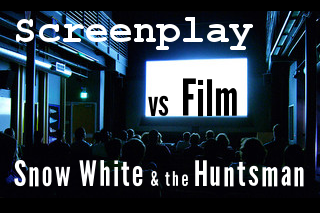Written by Evan Daugherty, SNOW WHITE AND THE HUNTSMAN was a spec screenplay which sold for $3.2 million.
Yowza!
At the time of the sale, retelling fairy tales was about to become a big trend. But Daugherty hadn’t written the script trying to capitalize on that. He had actually written it years before when he was a student at NYU.
According to this HitFix interview with the screenwriter, it didn’t sell at the time, but it did get him a manager. When Tim Burton’s ALICE IN WONDERLAND scored box office gold, Daugherty’s script became a scorching hot property.
What should you take away from this story? So much of success depends on luck–and patience. You can’t do anything about luck, but you can cultivate patience. While you’re at it, develop a thick skin (or at least the ability to take things in stride). Even though Daugherty made a huge spec sale, all didn’t end rosy. He was eventually kicked off of the project.
Before he was fired, he worked together with the director, Rupert Sanders, and modified several aspects of his original spec. Examining the differences between his 2003 screenplay draft and the film released in theaters yields a lot of practical screenwriting tips which I’ll share below.
There are 10 of them, to be precise, with lots of excerpts from the original spec. So this article is fairly long. You might want to print it out first, or at the very least, make sure you buckle down at your computer with a cup of tea or glass of lemonade!
Now, onto the 10 screenwriting tips I learned from SNOW WHITE AND THE HUNTSMAN:
Screenwriting Tip #1: Deliver on the genre goods ASAP
The first ten pages of your script will make or break your screenplay. If they’re compelling, powerful, and interesting, you can convince busy people who don’t really want to slog through yet another amateur script that yours warrants their attention.
And if you can keep their attention, then you might even convince them your screenplay is worthy of opening their pocketbooks.
But it all starts with the first ten pages of your script. Whatever genre your script falls into, you must PROVE IT within the first ten pages.
If you’ve written a romantic comedy, show the reader one element (preferably comedy) in the first ten pages. If you’ve written an action movie or a thriller, give the reader action or thrills or suspense. Spook the reader if you’ve written a horror script…and so on and so forth.
Let’s apply this principle to SNOW WHITE AND THE HUNTSMAN. In the original screenplay draft I read, the first few pages were a rehash of the fairy tale. A lot of emphasis was placed on Snow White’s childhood relationship with Prince Charmant (renamed William in the movie). We’re also introduced to Eric, the Huntsman, who’s become a selfish drunkard after the death of his wife.
It’s not a bad beginning by any means, but it doesn’t really deliver on the genre goods. If SNOW WHITE AND THE HUNTSMAN was supposed to retell the classic fairy tale as an action-adventure fantasy, then those elements needed to be there from the very beginning. And they weren’t–not in the original screenplay draft.
But they were in the movie.
Three and a half minutes into the film, we see the king, Snow White’s father, engaged in a battle with a mysterious Dark Army, composed of soldiers who splinter into a million bits of iron when killed.
It’s certainly not a lengthy sequence, only about 90 seconds long. But it delivers on the genre goods (both action and fantasy) right away, giving audiences just enough to whet their appetites for what’s to come.
To learn more about how to engage audiences at the very beginning of your script, read this »
Screenwriting Tip #2: Treat heroes and villains like the narcissists they are
If you want to attract A-List talent with a particular role, then make sure that role would please a narcissist. What do I mean by that?
These characters should have lots of scenes and screentime. They don’t disappear for pages at a time. They have several lines of dialogue. Not only that, but they also make plans and take action.
The way the original draft of SNOW WHITE was written, it’d be unlikely to attract an Oscar-winner like Charlize Theron simply because her character, Queen Ravenna, disappears for pages at a time.
For example, even though she’s the primary villain in the story, she doesn’t have a single line of dialogue from pages 16-28 or from pages 32-55. (Note: This also happened with Angelina Jolie’s character in The Tourist.)
In the script, the Huntsman was really the main protagonist, eclipsing both Snow White and Ravenna. We were constantly delving into his backstory and into his point of view. Furthermore, he knew that Snow White was the only one who had the ability to kill the seemingly invincible queen. Snow White didn’t.
Her destiny was basically under his control because it was his decision to tell her the truth or not. Because he gets to decide when to reveal that information, he has all the power in the script.
In the movie, Ravenna has more screentime–although she could have had even more. Additionally, Snow White learns that she is the only one who can kill Ravenna. The plot then focuses on the actions she takes to fulfill that destiny instead of focusing on the Huntsman’s dilemma.
(In fact, for half of the movie, he doesn’t even know she’s the princess.) It’s a subtle change, but it makes a big difference in how audiences perceive who the hero (or heroine) of the story truly is.
On a side note, the Huntsman very well could’ve been the star of the movie instead of Snow White. (I don’t think the movie would’ve been as commercially successful that way, but that’s not the point.) The point is that it didn’t seem like it was the screenwriter’s intention to make the Huntsman the hero (at least to me). It just happened inadvertently. And that’s what you want to avoid.
Screenwriting Tip #3: Character introductions should have impact
Your character introductions (both your lines of description and action in their first scene) should be as revealing as a portrait executed by the most talented painter. They should show us the essence of your character right away.
In the original screenplay draft of SNOW WHITE, Ravenna’s character introduction is glossed over very quickly. One minute, Snow White’s father, the king, is mourning his wife, and the next, he’s marrying Ravenna:
The funeral BECOMES A WEDDING. Snow White walks down the aisle, scattering red roses down on the long white carpet. Prince Charmant walks beside her as the ringbearer. They don’t seem very enthusiastic about their jobs…
That’s because the King is marrying a young, almost incomprehensibly beautiful trophy bride named RAVENNA.
This was a missed opportunity to give readers a window into Ravenna’s character. It’s a major omission because she’s the main villain of the script. Her introduction should have impact.
Contrast the screenplay with the movie, which seized the opportunity to show audiences who Ravenna really is. The first time we see her, she’s held captive by a Dark Army, whom the king has just vanquished.
In a voiceover by the Huntsman, we know more of her than her beauty. We learn that she is a witch with magical powers. She created the army in order to manipulate the king. In other words, we know who she is and how she operates.
As you may’ve noticed, Ravenna’s character introduction coincides with the fulfillment of genre expectations discussed in screenwriting tip #1. It’s a great example of how to accomplish multiple goals with your scenes. If you learn how to do that, you’re well on your way to becoming a truly great screenwriter.
Screenwriting Tip #4: Use the power of mass wisely
The concept of “mass people” was first introduced to me in Linda Seger’s book, Making A Good Script Great. Basically, the idea is that you show the importance of a character through the entourage of people accumulated around him…aka the “mass people.”
Then there are small supporting roles that provide mass and weight to demonstrate the prestige, power, or stature of the protagonist or antagonist.
The bodyguards, secretaries, assistants, right-hand men and gal Fridays that surround powerful men and women all help us understand who’s important.
This is an excellent tip. But if you want to apply it to your screenplay, think not just in terms of quantity but also in terms of quality. Since your VIP character is presumably in charge of hiring, the competence of the mass people (or their lack thereof) is a reflection of your VIP.
In the original screenplay draft of SNOW WHITE, Ravenna employed a bevy of employees, including Finn (who was just a scary henchman, not Ravenna’s brother); two brothers, Bruno and Bilge-Rat, who claimed they were identical twins when they really weren’t; a fawning trio of beauty emissaries; and a clever alchemist named Speck.
Because he was fairly competent, Finn did the best job of reinforcing Ravenna’s power. Bruno and Bilge-Rat weren’t particularly competent and were basically included for comic relief.
Although the two brothers added to the story’s humor, their inclusion incurred a negative side effect. They made Ravenna look incompetent by extension. This side effect was compounded by her lack of screentime and by the other “mass people” surrounding her.
For example, her beauty emissaries were also included for humorous effect. But they did more harm than good, diluting Ravenna’s menace. You can’t take Ravenna seriously when she’s surrounded by such a useless lot. Take a look:
Her three overdressed and over-coiffed male BEAUTY EXPERTS — THE TAILOR, THE HAIRDRESSER and THE COSMETOLOGIST — quickly dry her body, comb her hair and slip on her silk robe.
Behind Ravenna’s back and without her knowledge, they jostle with one another over access to the Queen. Slapping each other’s hand, elbowing each other, flashing dirty looks.
On the surface Speck, like Finn, seems to add to Ravenna’s image as a powerful villain.
SPECK, Ravenna’s jittery, bespectacled court alchemist climbs a small step ladder and pours assorted MAGICAL INGREDIENTS into a funnel on the sarcophagus.
Speck turns a STONE DIAL on the side of the sarcophagus. It starts to shake. Smoke shoots out the side.
[…]
The sarcophagus goes silent. And then, a spigot on the sarcophagus drops a phosphoreescent BLUE LIQUID into a VIAL.
Ravenna drinks the liquid. She’s already beautiful. But as soon as she swallows the liquid, her skin becomes even SMOOTHER, her eyes even BRIGHTER, her lips even FULLER.
And then, the sarcophagus door pops open, and a WITHERED OLD WOMAN steps out. The device has aged her by at least sixty years.
Speck’s talent for alchemy certainly make him a valuable employee. But Ravenna’s supposed to be a powerful sorceress. Why then does she need to rely on the abilities of an alchemist? By deduction, her magical powers can’t be that strong at all…and then what kind of villain is she?
The movie solved this problem by only keeping Finn’s character. (It actually turns him into Ravenna’s brother, which makes him even creepier.) The other mass people are eliminated. Ravenna didn’t have to rely on an alchemist to create magic. She did everything herself–including sucking the youth directly from beautiful girls–which made her much more formidable.
Note: the original screenplay draft was aiming for a more PRINCESS BRIDE-like tone. Because of that, it makes sense that the screenwriter included comic relief such as Bruno and Bilge-Rat. Even so, I think it would’ve been better to make them humorous characters while still maintaining their competence.
For a great example of how to do that, watch The Devil Wears Prada. Miranda (the villain) has a first assistant named Emily, who’s the picture of efficiency.
At the same time, Emily’s terrified of Miranda and condescending towards the second assistant, Andy. This combination manages to elevate Miranda’s status while still contributing to the movie’s humor.
An alternative approach is to give the hero a bumbling set of accomplices (or adversaries turned accomplices) whom he’s stuck with. This strategy worked in BEVERLY HILLS COP. While full of good intentions, Rosewood and Taggart don’t possess the same investigative skills as Axel Foley.
Screenwriting Tip #5: All victories are false until “The End”
Whenever it appears that your hero has achieved success, he should discover that a new challenge/obstacle awaits him…at least until you reach the resolution of your screenplay.
This contrast between success and failure creates a deeply satisfying viewing experience, keeping your audiences engaged throughout your script.
In both the screenplay draft and produced film of SNOW WHITE, there’s a scene which revolves around a battle between a troll and Snow White and the Huntsman.
It looks like the troll will kill both of them. In the screenplay, they work together to kill the troll. In the movie, Snow White quells the troll with a loving glance.
There’s another difference between the two scenes: their placement. In the screenplay, Snow White and the Huntsman’s encounter with the troll occurs while they’re in the middle of their foray into the enchanted forest. In the movie, it occurs just as they’re about to exit it.
See the difference?
They’re about to escape from the creepy forest (+), but at the last minute, they’re almost killed by a troll (-).
This structure increases the stakes because Snow and the Huntsman are thisclose to victory…
…making their loss all the more acute if they fail…
…and all the sweeter if they succeed.
It’s a small difference, but it makes the overall viewing experience more intense and more engaging.
Screenwriting Tip #6: Trim the fat
Avoid showing your audiences the same thing twice. Pick the best scene which illustrates a character trait, for example, and move on. In the original draft of SNOW WHITE, we’re shown twice that Ravenna’s magical powers allow herself to heal her body.
The first time is with the Huntsman:
All bets are off now. In a flurry of motion, Eric draws a hatchet, flings it and hits Ravenna IN THE CHEST.
But then, something incredible happens–
Ravenna pulls the hatchet out of her own chest–
AND THE MASSIVE WOUND QUICKLY HEALS.
Eric and Snow White share a look. Ravenna’s MAGICAL INVINCIBILITY is as surprising to them as it is to us.
The second time occurs in a flashback to her childhood:
Ravenna’s Mother forces her daughter to guzzle down the foul tasting potion.
And then, Ravenna’s Mother grabs a curved dagger and gently CUTS A SCRATCH into her daughter’s arm.
Ravenna recoils at first, but it soon becomes clear that she feels no pain. Seconds later, the blood is drawn back into her body. And Ravenna’s wound miraculously closes up.
The first one is much stronger–visually and viscerally. So it should come as no surprise that this is the scene which was kept in the movie (although reworked so that it takes place in front of a young rebel and his dad instead of in front of the Huntsman and Snow White).
The second scene with Ravenna’s mother is included in the movie too–but not to show Ravenna’s self-restorative powers. Instead, the primary focus is on how the spell can be undone by “the fairest blood.”
Screenwriting Tip #7: Be consistent
Admittedly, this is easier said than done! It can be tricky to keep track of all of your plotlines, logistics, character traits, and motivations for 100+ pages.
But readers and movie-goers definitely will, so you must be vigilant about consistency too!
Going back to SNOW WHITE AND THE HUNSMAN, in the original script, Ravenna decides to form an allegiance through marriage to King Bloodaxe, who’s managed to ravage his country even more than she has hers. In fact, the climax of the script occurs during their wedding (where it’s revealed that both were planning to kill the other on their wedding night).
Despite Ravenna’s admission that she was going to kill him anyway, her decision to get married doesn’t make sense. It’s not consistent with the way Ravenna is portrayed.
If she’s supposed to be a menacing, all-powerful witch, then she should be as destructive as King Bloodaxe. Otherwise, she appears weaker in comparison–not what you want for your main villain.
That’s not the only way Ravenna’s marriage to Bloodaxe hits a discordant note. The king wants to marry the “fairest in the land.” He even proposes to marry Snow White instead of Ravenna, a plan Ravenna squashes by claiming Snow White died “tragically in a hunting accident.”
In other words, the decision to get married appears to rest solely in his hands–not Ravenna’s. Again, if she’s supposed to be all-powerful, then she should be able to manipulate Bloodaxe to do her bidding the same way she did with Snow White’s dad. She should be sure of her success, and not dependent upon Bloodaxe’s goodwill.
There’s another inconsistency with regards to Ravenna’s character too. She spends half the movie hunting Snow White but when she finally apprehends her and fools her into biting a poisonous apple, she doesn’t kill Snow.
Of course, Snow White can’t die yet–we still need her to finish off Act Three. But this contrivance strains all credibility, making Ravenna look like an utter fool.
The movie solved this issue by having Ravenna poison Snow White and then attempt to stab her…only she’s foiled by the appearance of William and the Huntsman. (The movie also mercifully eliminated the character of King Bloodaxe completely.)
While I’m on the topic, the ending of the script is also inconsistent with regards to Snow White’s portrayal. We’re supposed to believe that she alone can conquer Ravenna. We’re also to led to believe that this screenplay puts an action-adventure twist on the fairy tale…which means that we should see Snow White as an action-adventure heroine.
She should be leading the charge against Ravenna. But in the script, this falls to the Huntsman and Prince Charmant. First, the Huntsman rallies others to their cause:
Eric starts to address all the women in the dungeon:
ERIC
The Queen is my enemy now. And she must be destroyed. But I need your help to do it.
REDHEAD
We can’t– it’s impossible– we’re– we’re all alone.
ERIC
You are not alone! We can get out of this! Together.
Meanwhile, Prince Charmant issues the orders:
EXT. OVERLOOKING RIDGE
Amidst Duke Charmant’s calvary, Snow White waits on horseback. She wears a leather tunic and light mail.
Prince Charmant and a small force of TEN KNIGHTS ride to her.
PRINCE CHARMANT
Ready?
SNOW WHITE
(with a smile)
Not really.
And then, Prince Charmant and his knights snap their visors shut. Prince Charmant draws his sword–
PRINCE CHARMANT
CHARGE!!!
Prince Charmant, Snow White, and the small team of knights ride down the hill at a breakneck pace, towards the LOWERED DRAWBRIDGE.
If Snow White is really the heroine, shouldn’t she be rallying the troops and yelling “charge?” That’s what happened in the movie.
Here’s an excerpt of her rallying speech: “Iron will melt. But it will writhe inside of itself…I have never seen a brighter light than when my eyes just opened. And I know that light burns in all of you! Those embers must turn to flame.”
I thought her fixation on iron was weird and not at all inspirational but at least she made the speech. She also helmed the charge against Ravenna’s castle. She was at the forefront of the action, the way we’d expect her to be as the heroine of the movie.
Her–not William…and not the Huntsman.
Screenwriting Tip #8: Don’t be clever for cleverness’s sake
If you come up with a clever twist, make sure there’s a reason for it. Don’t just include a twist in your story without paying it off. For example, in the script of SNOW WHITE, Eric the Huntsman and Ravenna were formerly lovers.
Say what?
Sure, it was unexpected. But after the shock wore off, I was confused. What was the point? If their past relationship led to a scene where Ravenna was able to trick Snow White and the Huntsman due to knowledge she gleaned during her torrid affair with him, then it might have worked. But the way it was written, this twist did more harm than good.
Also, in the script, Snow White’s dad was a lech. The original purpose of the magic mirror was to help him find increasingly younger brides:
KING
I have come for the fairest woman in the land! The one who is to be my bride! Bring her to me!
The King looks to one of his SQUIRES, who holds the familiar MAGIC MIRROR in his hand. The Magic Mirror shows a cloudy image of RAVENNA. This was the mirror’s original function: for the King to find the most beautiful women in the land.
KING (CONT’D)
Bring out Ravenna!
The magic mirror twist is clever, and if I had come up with it, I probably would’ve kept it too. But as a movie-goer, I would’ve wondered what was the point. It doesn’t seem to lead to any sort of payoff.
Plus, it makes you wonder if perhaps Snow White’s life with her dad might’ve been just as bad as her life with Ravenna in charge.
That’s not to say all the clever twists in the original screenplay draft of SNOW WHITE didn’t pay off. In this draft, the Huntsman’s job is actually to hunt down youthful women whose beauty Ravenna would extract using Speck’s special sarcophagus. (Say that three times fast!)
By the the end of the script, he has to beg these women he’s hunted to help him. They work together, side-by-side, to lower the drawbridge leading to Ravenna’s castle. In the movie, the scene was tweaked so that the dwarves, not the women, work together to raise the portcullis of Ravenna’s castle. Both work well.
Which one do you like better?
Screenwriting Tip #9: Have good join evil (at least temporarily)
In the original script of SNOW WHITE, Prince Charmant overhears Ravenna issuing instructions to a bunch of bounty hunters, and then proceeds to track down Snow White on his own. In the movie, he joins the gang of bounty hunters, headed by Ravenna’s brother, Finn.
This change added new intrigue to the midpoint action set piece in which Finn leads an attack against the river village where Snow White and the Huntsman are hiding. I was constantly wondering how William could protect Snow White without revealing his intentions to Finn and the other bounty hunters.
At the same time, since many years had transpired since Snow had seen William, she probably wouldn’t recognize him. So I was also wondering if she might harm him before she realized his true identity.
This difference added a lot of suspense to an already action-packed scene. Maybe it will do the same in your own screenplay!
Screenwriting Tip #10: Don’t introduce new antagonists late in the game
It’s almost always better to introduce your primary villain and his henchmen at the beginning of your script, and have your hero battle this same group throughout.
This will give your script more clarity and cohesion. It will also decrease the likelihood that your script will come across as “episodic.”
Another plus–it will be easier for the reader to keep track of what’s going on because you haven’t over-populated your screenplay with too many characters.
Additionally, as you saw in screenwriting tip #4, if you introduce too many villains and/or henchmen, you can dilute the power of your primary villain.
In the screenplay draft of SNOW WHITE that I read, a new foe was introduced late in the script: bomb-throwing fairies. Yes, they were definitely cool. But they seemed to come out of nowhere and existed just for the coolness factor:
INT. ICE MINE
The dwarfs are busy at work throughout the mine.
BUT ON A HIGH STALACTITE
There’s an EVIL FAIRY perched. The fairy pulls a BOMB from his belt. He lights it, tosses it down.
KA-BLAM!!! The bomb bears into the cave wall. Rocks fly.
The EVIL FAIRIES have come.
In the movie, the bomb-throwing fairies were eliminated altogether. Instead, the film opted to stick with benevolent fairies. (Although when I think about it, their introduction was kind of random too.)
However, the bomb-making fairies could’ve worked in both the script and the movie if they had been introduced early on. For example, in Act One, Ravenna may send a message to them which alerts us to their presence.
Then, when they show up late in Act Two, it’s still a surprise (because so much time has elapsed since their initial introduction) but it doesn’t come across as random (because they were already set up in Act One).
If you want a more contemporary example of maintaining the same antagonists throughout your script, check out screenwriting tip #6 from Safe House. One of the big changes between the script and the film had to do with the composition of the villain’s team of henchmen.
Final thoughts
SNOW WHITE AND THE HUNTSMAN is a great movie to study if you’re writing a screenplay based on material available in the public domain. That being said, I think the trend of retelling fairy tales is on its way out.
Not because audiences have tired of them yet. But Hollywood has already bought a number of high-profile projects, including two retellings of Sleeping Beauty. One will star Angelina Jolie while the other has that girl from TRUE GRIT attached as the lead. I think agents and studio executives are now looking for the next big trend.
What do you think that trend will be? And what did you think of SNOW WHITE AND THE HUNTSMAN?
Watching a blank screen (with modifications) by Kenneth Lu




















